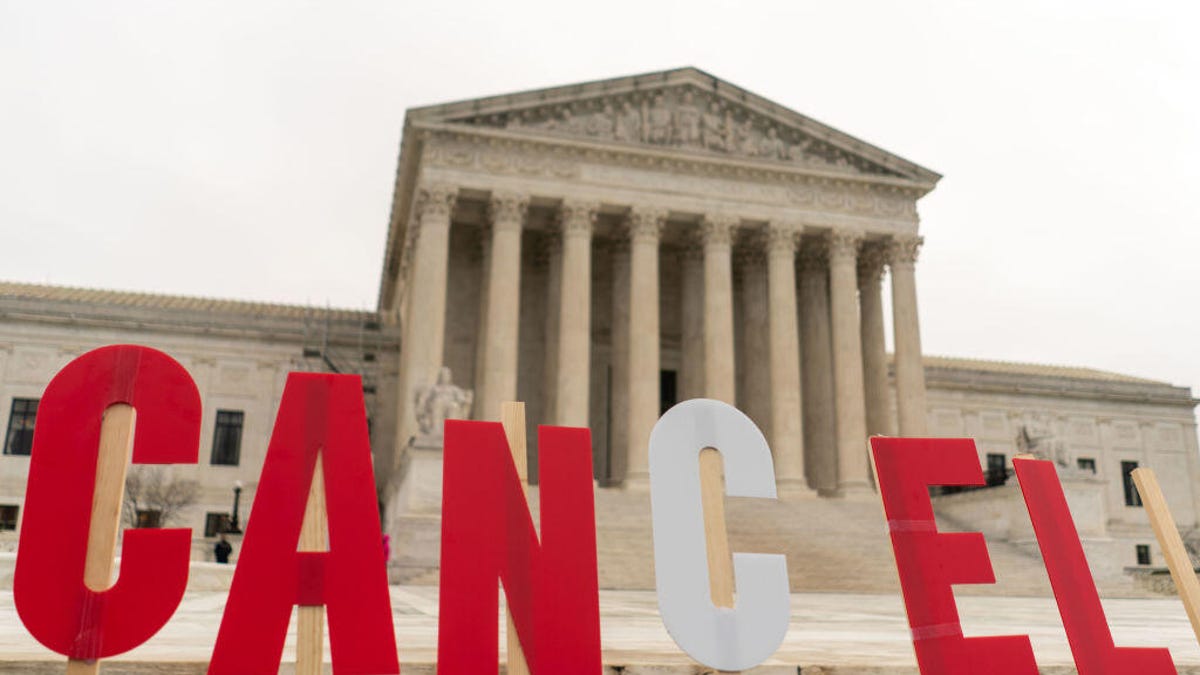What the Supreme Court Ruling Means for Biden's Student Loan Plan
The court decided that the plan to forgive up to $20,000 per borrower was an overreach of the executive branch.

The Supreme Court struck down Biden's plan for student loan forgiveness, but the president has promised to keep fighting for debt relief
On Friday, the US Supreme Court struck down President Joe Biden's plan to forgive up to $20,000 in federal student loan debt per eligible borrower. In a 6-3 split along ideological lines, the court agreed with six state attorneys general who argued that the forgiveness plan wasn't authorized under the Higher Education Relief Opportunities for Students Act of 2003.
Associate Justices Elena Kagan, Sonia Sotomayor and Ketanji Brown Jackson dissented.
In the majority opinion, Chief Justice John Roberts wrote, "We expect Congress to speak clearly if it wishes to assign to an agency decisions of vast 'economic and political significance,'" citing the 2014 decision in the Supreme Court case Utility Air Regulatory Group v. EPA.
On a second challenge, the court decided unanimously that the plaintiffs -- two borrowers who claimed the Biden administration failed to allow for the traditional comment period -- had no standing in the case.
The president described the ruling as "disappointing," but insisted the fight for education debt forgiveness "is not over."
"I will stop at nothing to find other ways to deliver relief to hard-working middle-class families," he said in a statement.
Here's what to know about the Supreme Court ruling, including what it means for student loans and what the Biden administration's next steps are for helping borrowers.
For more on student loans, find out when payments will resume, who your student loan provider is and what experts recommend borrowers do next.
What did the Supreme Court decide about Biden's student loan forgiveness plan?
On June 30, the last day of the current term, the Supreme Court ruled that the White House's debt forgiveness plan was unconstitutional and that Biden and Education Secretary Miguel Cardona didn't have the authority to forgive $430 billion in student loans without congressional approval.
When the White House introduced the plan in August 2022 to forgive federal student loan debt for borrowers earning less than $125,000, Biden argued that it fell under the HEROES Act, which grants the Department of Education authority to waive student loan repayments for those affected by "a war or other military operation or national emergency."
The legislation was passed in 2003, in anticipation of the Iraq War. On Friday, though, the high court ruled that the HEROES Act didn't apply to the COVID-19 pandemic and economic upheaval of the past three years.
"We hold today that the Act allows the Secretary to 'waive or modify' existing statutory or regulatory provisions applicable to financial assistance programs under the Education Act, not to rewrite that statute from the ground up," Roberts wrote.
Read on: Student Loan Forgiveness Is Out. Experts Explain What Borrowers Should Do Next
Biden's plan would've eliminated up to $10,000 in student loan debt for borrowers earning up to $125,000 annually, or up to $250,000 for married couples. Borrowers who'd received Pell Grants would be eligible for an additional $10,000.
According to the White House, 44 million Americans would've benefited from the education debt forgiveness program, with 20 million seeing their balances erased entirely.
What's next for student debt forgiveness?
The court's opinion is a major blow to Biden's campaign promise to tackle education debt. But after Friday's ruling, the president outlined three paths to assist those with student loan debt.
The first, detailed by Education Secretary Miguel Cardona, is a new income-driven repayment plan, Saving on a Valuable Education, that would cap payments at 5% of a borrower's discretionary income, down from the previous 10%.
The repayment plan will also "cut payments to zero dollars for millions of people making less than $33,000 a year. All other borrowers will save at least $1,000 per year," Cardona said during a White House briefing.
Second, the administration will create an "on-ramp" period from Oct. 1, 2023, to Sept. 30, 2024, when borrowers who miss monthly payments "will not be considered delinquent, reported to credit bureaus, placed in default, or referred to debt collection agencies," according to the Education Department. Interest will accrue during the period.
Third, Biden and Cardoza both said they would try authorizing broad relief via a different path, but offered few details other than the formation of a "rulemaking committee" to prepare proposed regulations. "Our goal is to provide relief to as many borrowers as possible under this process," Deputy Director of the National Economic Council Bharat Ramamurti said during a White House briefing on the plan.
Congress could also pass legislation to help education loan borrowers. But with Biden vetoing a bill in June that would've killed his relief plan, a legislative path may not be open.
When do I have to start repaying my student loans?
Payments and interest on federal student loans have been paused since the start of the pandemic, in March 2020. A provision in the debt ceiling deal passed by Congress cemented a June 30 deadline for the end of the forbearance and prevents any further pauses without congressional approval.
The Department of Education has announced that interest will restart on Sept. 1, with payments resuming in October.
Who has already received student loan debt relief?
Outside of Biden's new plan to student debt relief, the Department of Education has already discharged billions of dollars in student loans, including for borrowers with disabilities and students who were misled or defrauded by educational institutions and through the Public Service Loan Forgiveness program. Here's who's already received debt relief.
For more, find out whether you can pay your student loans with a credit card.

